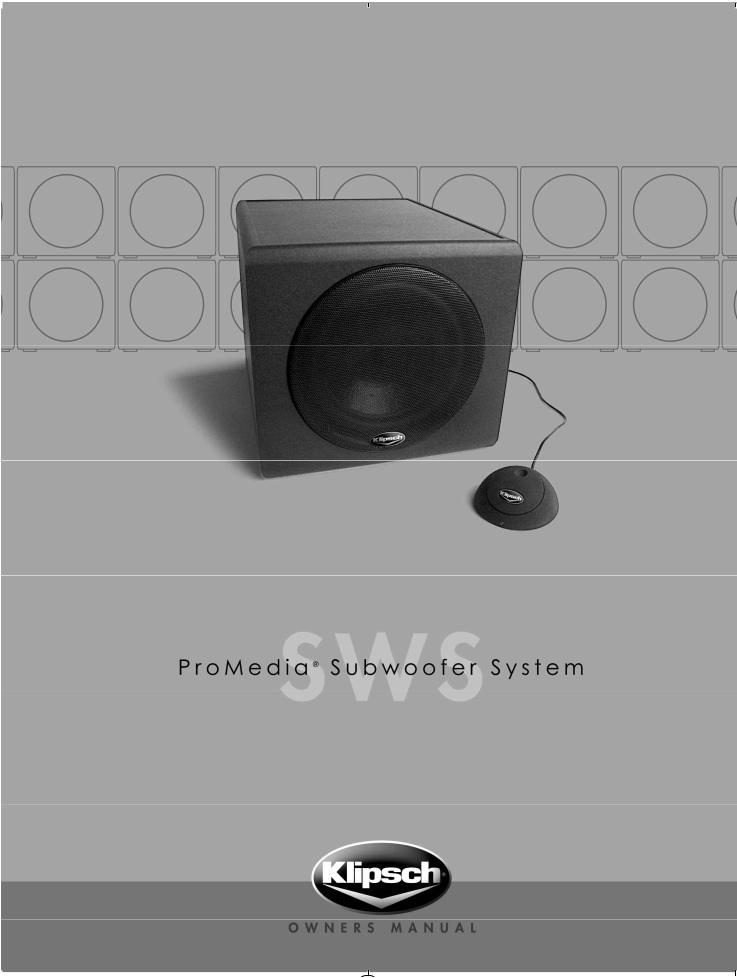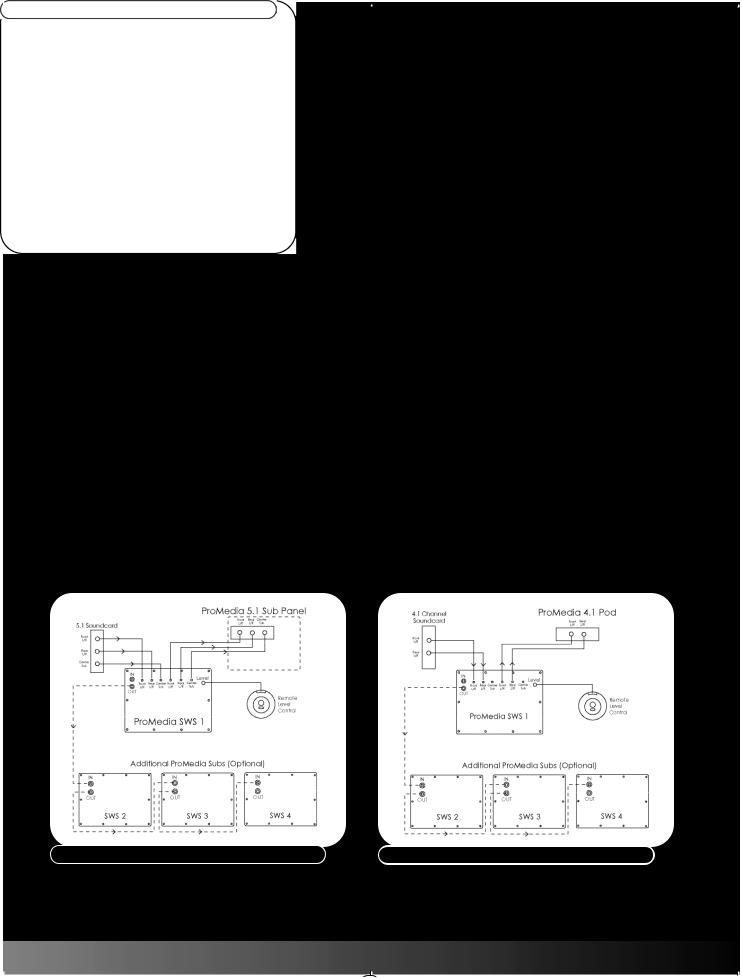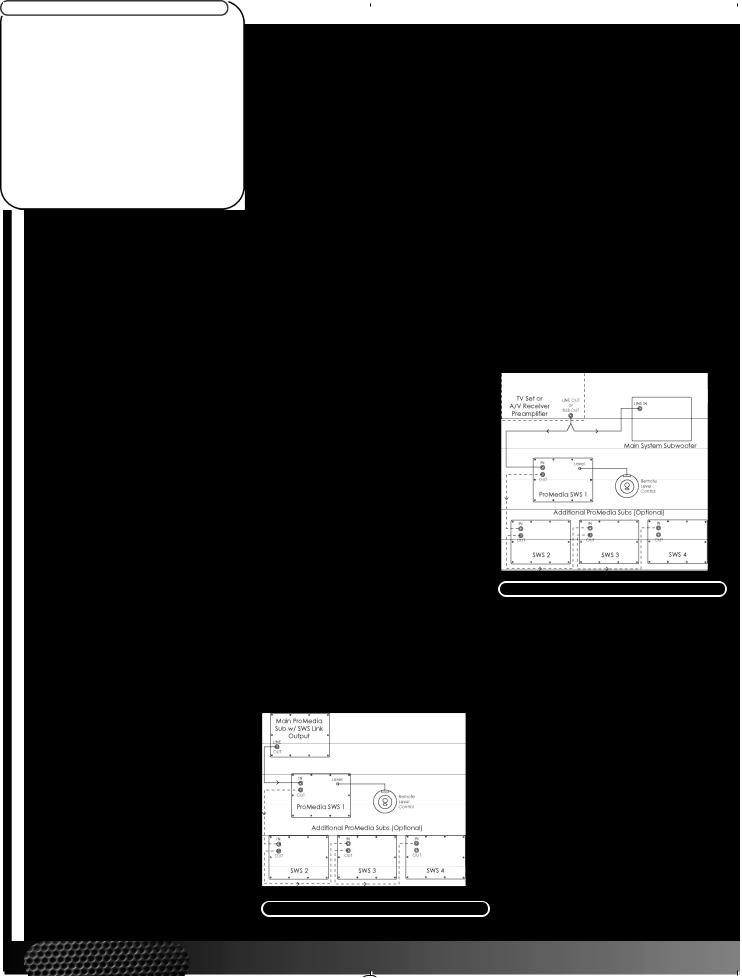Klipsch ProMedia SWS User Manual


IMPORTANT SAFETY INSTRUCTIONS!
CAUTION: RISK OF ELECTRIC SHOCK! DO NOT OPEN!
CAUTION! To reduce the risk of electric shock and fire, do not remove the cover or back plate of the device enclosure. There are no user serviceable parts inside. Refer servicing to a Klipsch authorized service center.
CAUTION! The international symbol of a lightning bolt inside a triangle is intended to alert the user to uninsulated "dangerous voltage" within the device enclosure. The international symbol of an exclamation point inside a triangle is intended to alert the user to the presence of important operating, maintenance and servicing information in the manual accompanying the device.
WARNING! To reduce the risk of fire or electrical shock, do not expose this equipment to rain or moisture.
1.Read Instructions – All safety and operating instructions should be read before operating the device.
2.Retain Instructions – The safety and operating instructions should be retained for future reference.
3.Heed Warnings – All warnings on the device and in the operating instructions should be adhered to.
4.Follow Instructions – All operating and safety instructions should be followed.
5.Attachments – Do not use attachments not recommended by the product manufacturer as they may cause hazards.
6.Water and Moisture – Do not use this product near water (for example, near a bath tub, wash bowl, kitchen sink, or laundry tub; in a wet basement; or near a swimming pool; and the like).
7.Ventilation – Slots and openings in the cabinet are provided for ventilation and to ensure reliable operation of the product and to protect it from overheating, and these openings must not be blocked or covered. The openings should never be blocked by placing the product on a bed, sofa, rug, or other similar surface. This product should not be placed in a built-in installation such
as a bookcase or rack unless proper ventilation is provided or the manufacturer’s instructions have been adhered to.
8.Heat – This product should be situated away from heat sources such as radiators, heat registers, stoves, or other products (including amplifiers) that produce heat.
9.Power Sources – This product should be operated only from the type of power source indicated on the marking label. If you are not sure of the type of power supply in your home, consult with your product dealer or the local power company. For products intended to operate from battery power, or other sources, refer to the operating instructions.
10.Polarization – This product may be equipped with a polarized alternating-current line plug (a plug having one blade wider than the other). This plug will fit into the power outlet only one way. This is a safety feature. If you are unable to insert the plug fully into the outlet, try reversing the plug. If the plug should stilll fail to fit, contact your electrician to replace your obsolete outlet. Do not defeat the safety purpose of the polarized plug.
11.Power-Cord Protection – Power-supply cords should be routed so that they are not likely to be walked on or pinched by items placed upon or against them, paying particular attention to cords at plugs, convenience receptacles, and the point where they exit from the product.
12.Overloading – Do not overload wall outlets, extension cords, or integral convenience receptacles as this can result in a risk of fire or electrical shock.
13.Lightning and Periods of Non-Use – For added protection for this product during a lightning storm, or when it is left unattended and unused for long periods of time, unplug it from the wall outlet and disconnect the antenna or cable system. This will prevent damage to the product due to lightning and powerline surges.
14.Cleaning – Unplug this product from the wall outlet before cleaning. Do not use liquid cleaners or aerosol cleaners. Use a damp cloth for cleaning.
15.Object and Liquid Entry – Never push objects of any kind into this product through openings as they may touch dangerous voltage points or shortout parts that could result in a fire or electric shock. Never spill liquid of any kind on the product.
16. Damage Requiring Service – Unplug this product from the wall outlet and refer servicing to qualified service personnel under the following conditions:
a)When the power-supply cord or plug is damaged,
b)If liquid has been spilled, or objects have fallen into the product,
c)If the product has been exposed to rain or water,
d)If the product does not operate normally by following the operating instructions. Adjust only those controls that are covered by the operating instructions as an improper adjustment of other controls may result in damage and often will require extensive work by a qualified technician to restore the product to its normal operation,
e)If the product has been dropped or damaged in any way, and
f)When the product exhibits a distinct change in performance – this indicates a need for service.
17.Replacement parts – When replacement parts are required, be sure the service technician has used replacement parts specified by the manufacturer or have the same characteristics as the original parts. Unauthorized substitutions may result in fire, electric shock, or other hazards.
18.Safety Check – Upon completion of any service or repairs to this product, ask the service technician to perform safety checks to determine that the product is in proper operating condition.
19.Servicing – Do not attempt to service this product yourself as opening or removing covers may expose you to dangerous voltage or other hazards. Refer all servicing to qualified service personnel.
If this unit is purchased outside of the U.S., please contact your local dealer or distributor for service center information. If purchased inside the U.S. and dealer service is not available, contact Klipsch Customer Service for a return authorization (RA) number before shipping. For further service information, contact:
KLIPSCH CUSTOMER SERVICE
3502 WOODVIEW TRACE, SUITE 200 INDIANAPOLIS, IN 46268-1104 1-888-554-5665 WWW.KLIPSCH.COM

Welcome to the Klipsch ProMedia ® SWS subwoofer system.
Your SWS subwoofer will add a new dimension to your enjoyment of your multimedia sound system. We have designed the SWS subwoofers to work with almost any type of speaker system, from stereo to 5.1 surround. In this manual, we will explain the three basic connection scenarios for your SWS subwoofer, based on the type of system you will be using it with, and how to operate it in each of them.
IMPORTANT NOTE:
Before You Begin!
Do not plug in the SWS’s power cord until all other wiring is completed. Make sure that all other parts of the system, including the computer, are turned off or disconnected from power while you are installing the SWS. Be especially careful not to connect or disconnect any signal cables while power is applied. Failure to observe this caution may result in loud hums, buzzes, or pops that will at the very least be startling and annoying and that in the extreme may damage your speakers.
Signal Connections
The Klipsch ProMedia SWS subwoofer can be used with any ProMedia® or multimedia speaker system. It can also be used to supplement the bass output from a TV set or home audio system that has appropriate line-level output jacks, although the signal connections are different. Connections are also different when the SWS is used with Klipsch ProMedia speaker systems that have the SWS-Link subwoofer output jacks. Each type of signal connection is described and diagramed separately later, followed by directions on connecting the volume-control module, attaching multiple SWS subwoofers, and placement and setup.
SETUP
Multimedia Speaker System (Figs. 1 & 2)
The SWS subwoofer allows pass through connection of as many as six channels from your computer’s sound card to your multimedia speaker system, using standard stereo minijack connectors. The subwoofer picks up and reproduces low frequencies from the signals on all these channels as they pass through it on the way to the main speaker system.
On the subwoofer’s back panel are three input/output minijack pairs: one green pair for left and right front channels (FRONT L/R) , a second black pair for left and right surround channels (REAR L/R), and a third orange pair for center channel and subwoofer (CENTER/SUB). If you have a twospeaker system, you will use only the first pair. If you have a three-piece speaker system, you will use the first pair, and if you have a 4.1 system, you will use the second pair as well.
If you have a 5.1-channel speaker system, you will use all three pairs.

1.Unplug your multimedia speaker system from your computer’s sound card or sound outputs, making careful note of which output jack is associated with each speaker connection. Usually the plugs and jacks will be color-coded GREEN for front left/right and BLACK for surrounds (rear), with the front jack directly above the surround jack on the back of the sound card. Placement and color coding of the jack used for center/subwoofer (center/bass) output, if any, varies from card to card; Klipsch uses ORANGE miniplugs and minijacks for this connection.
2.Plug the cables from your speaker system into the corresponding OUTPUT minijacks on the SWS subwoofer’s back panel. The cable for the front left and right speakers plugs into the GREEN OUTPUT jack. The cable for surround speakers (if any) plugs into the BLACK OUTPUT jack. The cable for a center speaker and a separate bass module (if any) plugs into the ORANGE OUTPUT jack.
3.Use the cables supplied with the SWS to connect its INPUT minijacks to your computer’s sound card. Attach the cable with a GREEN miniplug at each end to the front left/right sound card output and the SWS subwoofer’s FRONT L/R INPUT. Plug the cable with BLACK miniplugs into the surround (rear) sound card output (if any) and the SWS subwoofer’s REAR L/R INPUT. Plug the cable with ORANGE miniplugs into the center/ subwoofer (center/bass) sound card output (if any) and the SWS subwoofer’s CENTER/SUB INPUT. Your input connections to and output connections from the SWS should match. For example, if the REAR L/R output is connected, so should the REAR L/R input. But if the REAR L/R output is not connected, neither should the REAR L/R input.
Klipsch ProMedia Speaker System with Subwoofer Outputs (Fig. 2)
The directions in this section apply to Klipsch ProMedia multimedia speaker systems which have the SWS-link subwoofer output jacks. For earlier ProMedia models, follow the instructions in the previous section.
On the SWS subwoofer’s back panel is an RCA (phono) INPUT jack. Use an RCA audio interconnect cable (one is supplied with the SWS) to connect this input to the RCA SUBWOOFER OUTPUT (SWS-link) jack on your ProMedia speaker system. This is the only signal connection you need to make unless you are using multiple SWS subwoofers (see “Multiple Subwoofers”).
TV Set (Fig. 3)
An SWS subwoofer can add a solid bass foundation to the sound from a TV set’s built-in speakers, if the TV has a line-level audio output jack. You will need to make a single connection to the RCA (phono) INPUT jack on the SWS subwoofer’s back panel.
Most TV sets sold today have one (mono) or two (stereo) audio line output jacks on their back panels. A mono audio output will be a single RCA (phono) jack, usually with a black inner ring for identification. A stereo audio output will be two RCA jacks, one with a white (or occasionally
black) inner ring, the other with a red inner ring. (RCA jacks with yellow inner rings are for video.) Use an audio interconnect cable with RCA plugs at each end (one is supplied with the SWS) to connect one of these output jacks to the RCA INPUT jack on the SWS subwoofer’s back panel.
Even if the TV’s audio output is stereo, use only one of the two jacks; this will not impair performance. If the TV has one set of audio outputs labeled "Fixed" or "Fixed Level" and another labeled "Variable" or "Variable Level," make sure you use one of the variablelevel jacks.
Home Audio System (Fig. 4)
You can connect the SWS to any home audio system that has a subwoofer output or preamp outputs for its front left and right channels. Just use an audio interconnect cable with RCA plugs at each end (one is supplied with the SWS) to connect one of these output jacks to the RCA INPUT jack on the SWS subwoofer’s back panel.
If the system has both subwoofer and preamp output jacks, use the subwoofer output. And if the subwoofer output is on an A/V receiver or amplifier, make sure you go into its bassmanagement setup menu and set Subwoofer to "On" or "Yes."
